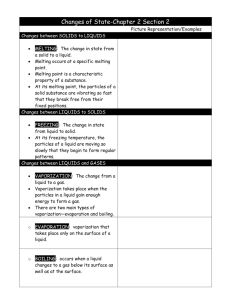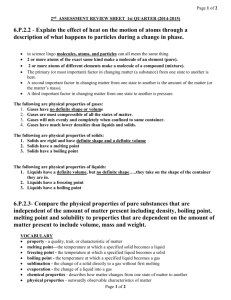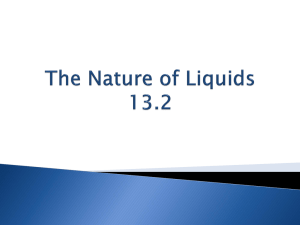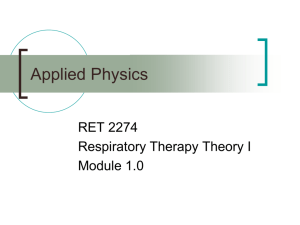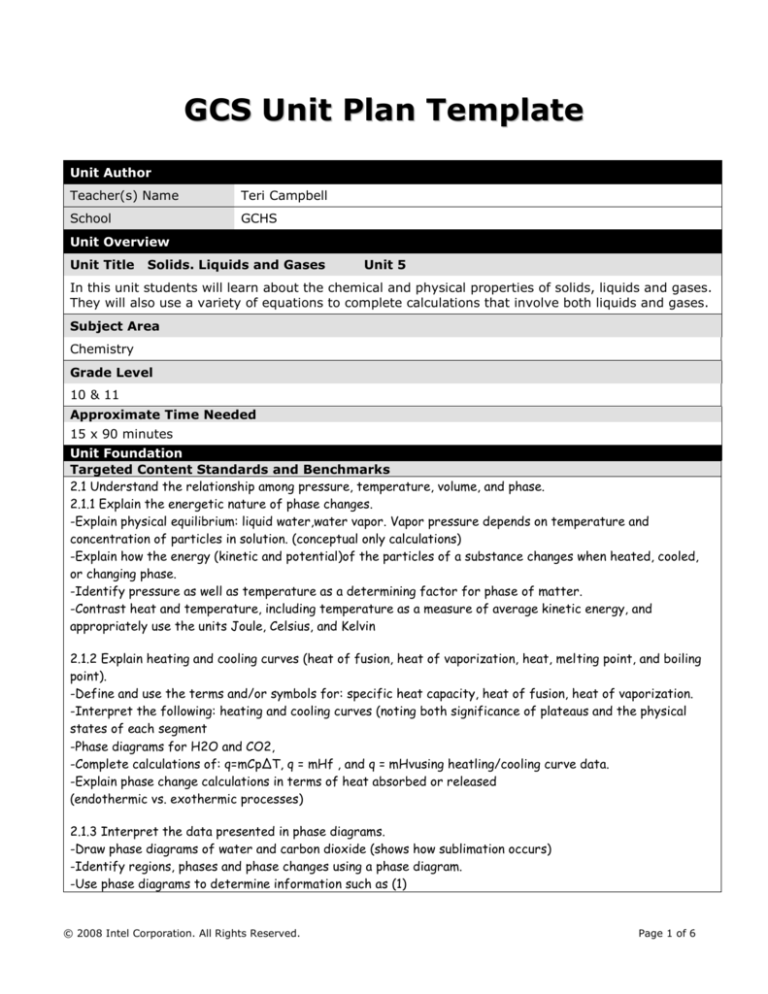
GCS Unit Plan Template
Unit Author
Teacher(s) Name
Teri Campbell
School
GCHS
Unit Overview
Unit Title
Solids. Liquids and Gases
Unit 5
In this unit students will learn about the chemical and physical properties of solids, liquids and gases.
They will also use a variety of equations to complete calculations that involve both liquids and gases.
Subject Area
Chemistry
Grade Level
10 & 11
Approximate Time Needed
15 x 90 minutes
Unit Foundation
Targeted Content Standards and Benchmarks
2.1 Understand the relationship among pressure, temperature, volume, and phase.
2.1.1 Explain the energetic nature of phase changes.
-Explain physical equilibrium: liquid water,water vapor. Vapor pressure depends on temperature and
concentration of particles in solution. (conceptual only calculations)
-Explain how the energy (kinetic and potential)of the particles of a substance changes when heated, cooled,
or changing phase.
-Identify pressure as well as temperature as a determining factor for phase of matter.
-Contrast heat and temperature, including temperature as a measure of average kinetic energy, and
appropriately use the units Joule, Celsius, and Kelvin
2.1.2 Explain heating and cooling curves (heat of fusion, heat of vaporization, heat, melting point, and boiling
point).
-Define and use the terms and/or symbols for: specific heat capacity, heat of fusion, heat of vaporization.
-Interpret the following: heating and cooling curves (noting both significance of plateaus and the physical
states of each segment
-Phase diagrams for H2O and CO2,
-Complete calculations of: q=mCp∆T, q = mHf , and q = mHvusing heatling/cooling curve data.
-Explain phase change calculations in terms of heat absorbed or released
(endothermic vs. exothermic processes)
2.1.3 Interpret the data presented in phase diagrams.
-Draw phase diagrams of water and carbon dioxide (shows how sublimation occurs)
-Identify regions, phases and phase changes using a phase diagram.
-Use phase diagrams to determine information such as (1)
© 2008 Intel Corporation. All Rights Reserved.
Page 1 of 6
phase at a given temperature and pressure, (2) boiling point or melting point at a given pressure, (3) triple
point of a material
2.1.4 Infer simple calorimetric calculations based on the concepts of heat lost equals heat gained and specific
heat.
-Recognize that, for a closed system, energy is neither lost nor gained only transferred between components
of the system.
-Complete calculations of: q=mCp∆T, q = mHf , q = mHv, and q lost=(-q gain)in water, including phase changes,
using laboratory data
2.1.5 Explain the relationships among pressure, temperature, volume, and quantity of gas, both qualitative and
quantitative
-Identifycharacteristics of ideal gases
Apply general gas solubility characteristics
Apply the following formulas and concepts of kinetic molecular theory.
1. 1 mole of any gas at STP=22.4 L
2.Ideal gas equation (PV=nRT), Combined gas law (P1V1/T1= P2V/T2 and applications holding one variable
constant:
for PV=k, P1V1= P2V2; for V/T=k, V1/T1= V2/T2; for P/T=k, P1/T1= P2/T2
Note: Students should be able to derive and use these gas laws,
but are not necessarily expected to memorize their names.
3.Avogadro’s law (n/V=k), n1/V1= n1/V2
4.Dalton’s law (Pt=P1+P2+P3..)
5.Vapor pressure of water as afunction of temperature (conceptually)
.
Student Objectives/Learning Outcomes
Students will be able to:
-define and use specific terminology that relates to phase changes and physical characteristics of
liquids and gases
-read and construct a vapor pressure/temperature graph
-read and construct a phase diagram graph
-read and construct a change of state graph
-compute total variables of the following equations whether they be 1, 2, 3, 4, or 5 step problems
(Q=m∆TCp, Q=mHf, Q=mHv)
-use a two sided equation showing heat absorbed = heat released to calculate variable
-explain the use of a calorimeter in chemical and physical changes.
-understand the effects of gas pressure and temperature on volume
-use the following equations to calculate gas variables PV = P2V2
PV = nRT PT = P1 +P2 + …
T
T2
Cross-Curricular Connections
© 2008 Intel Corporation. All Rights Reserved.
Page 2 of 6
Foods – affects of pressure on boiling point of water and cooking foods at higher elevations
English – students will write a lab paper
Curriculum-Framing Questions
Essential
Question
Unit
Questions
How do race mechanics use gas pressure in competition?
How do meteorologists use their understanding of the interaction of pressure,
volume and temperature when launching weather balloons?
Why is a gas a gas even though it is often found in liquid form?
What are the terms associated with liquids?
What information can be gleaned from a phase diagram, Vapor pressure
graph, and heating curve graph?
What are the definitions for the following terms:
Content
Questions
Solid, liquid, gas, melting, freezing, boiling, condensation, sublimation, normal
melting, normal boiling, heat of fusion, heat of vaporization, phase diagram,
volatile, liquefaction, etc..
Assessment Summary
Unit Details
Prerequisite Skills
Students should have a basic understanding of phase change terminology and the equation
Q=m∆TCp
Instructional Procedures
Day 1
Liquids terminology
Day 2
Reading, analyzing and drawing phase diagrams
http://sharepoint.mvla.net/teachers/DarrenD/Chemistry/Lists/Chem%20Calendar/Attachments/490/
Phase%20Diagram%20Worksheet%20KEY.pdf
Days 3 & 4
Phase diagram Quiz
Heating Curves/Change of states of graphs
Q=m∆TCp. Q=mHf, Q= mHv
“Chemo” Quiz on terminology(like Bingo)
Day 5
Quiz on 1,3,5 step problems
Day 6
Liquids Quest
Intro to Lab
Day 7
Melting and Freezing Pt Determination using Napthalene
Day 8
Gases
-Temperature Conversions
-Boyle’s and Charles’ Law
© 2008 Intel Corporation. All Rights Reserved.
Page 3 of 6
http://video.mit.edu/watch/boyles-law-pressure-vs-volume-8456/
Day 9
Review Boyle’ & Charles’ Laws
Combined Gas Law
Dalton’s Law
Graham’s Law
Day 10
Review CGL, Dalton’s, Graham’s Laws
Ideal Gas Equation - PV=nRT and PV = mRT/M
Day 11
Review Ideal Gas Law
Quiz on Ideal Gas Law
Day 12
Review with Study Guide
One group completes either Molecular Mass of Butane Lab or Charles’ Law Lab
Day 13
Other ½ of students will do the labs
Day 14
Complete Labs
Day 15
Unit Test
Accommodations for Differentiated Instruction
Special Needs
Students
Make labs accessible to students with special physical needs.
Gifted/Talented
Students
Compare ideal and real gases
Materials and Resources Required For Unit
Technology – Hardware (Click boxes of all equipment needed)
X Interactive Technology
Computer(s)/iPads, etc.
Digital Camera
X DVD Player
X Internet
Student Response
System/Clickers
Printer
X Projection System
Scanner
Cell Phone
Video Camera
Video Conferencing Equip.
Document Camera
Other
X Television
Technology – Software (Click boxes of all software needed.)
© 2008 Intel Corporation. All Rights Reserved.
Page 4 of 6
Database/Spreadsheet
Image Processing
Web Page Development
Desktop Publishing
Internet Web Browser
Word Processing
E-mail
Multimedia
Other
X Web-Based Encyclopedia
Test book Merrill and Prentice Hall and worksheets associated with each
Printed Materials
Teacher made worksheets
Supplies
Naphthalene, test tubes, thermometers, beakers, lighters, graduated
cylinders, Erlenmeyer flasks, burners,
Page 5 of 6
Unit Plan Reflection
Describe any adaptations or “tweaks” to the resource or lesson plan that were needed:
What do you plan to do differently the next time you teach this unit?:
The unique circumstances of a class of 33 required additional time for labs (twice as many days as usual). The
length of this unit will probably be about 2 days shorter when I have a class of 25 or less.
I will also include https://www.khanacademy.org/science/chemistry/ideal-gas-laws as a tutorial website for
future semesters.
Page 6 of 6



